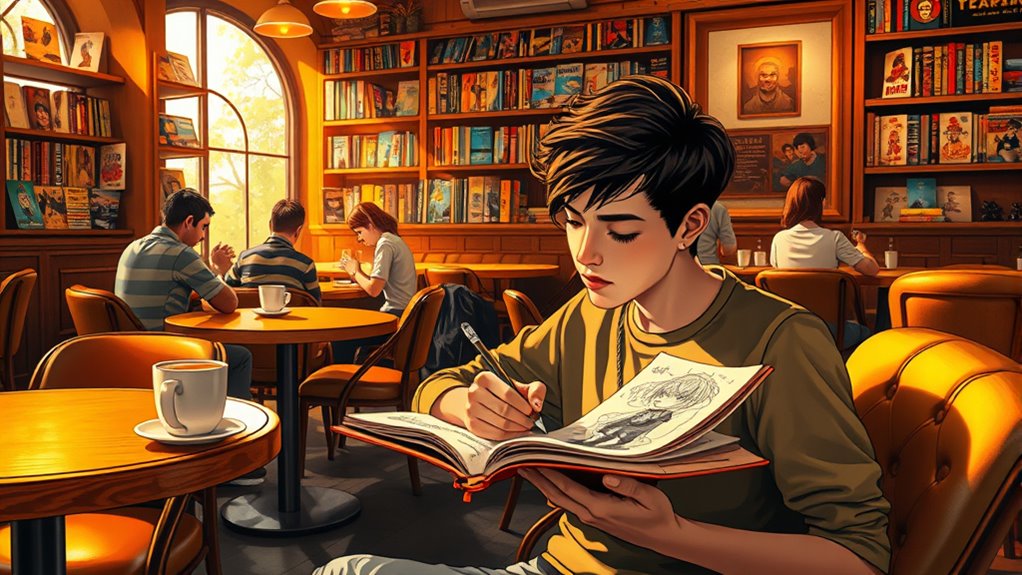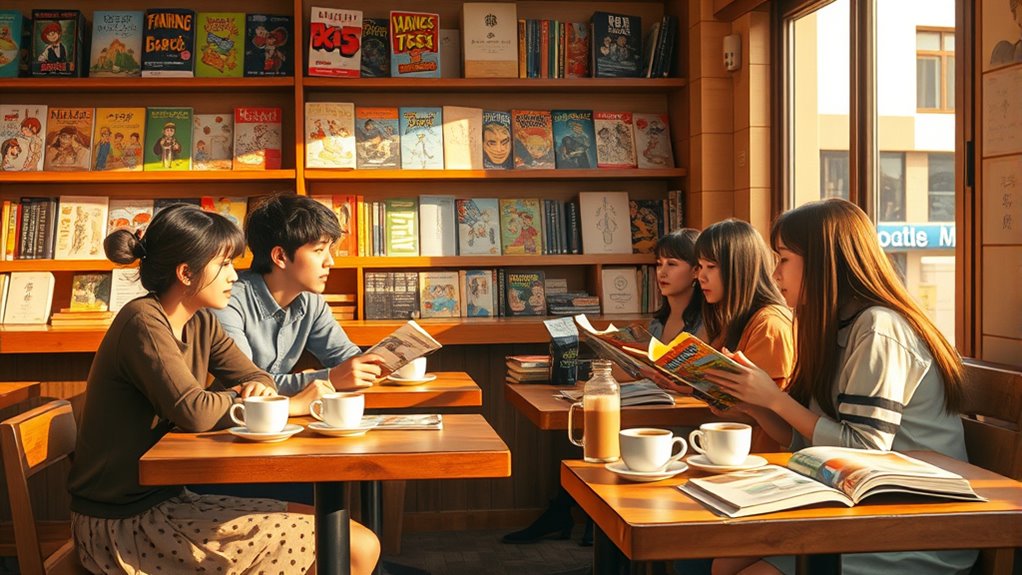In graphic novels and manga, cafés often symbolize safe spaces for characters to grow and connect. Themes include self-discovery, healing, and unexpected encounters that change lives. Tropes like secret crushes, chance meetings, and heartfelt conversations are common, offering moments of vulnerability and transformation. The cozy, familiar setting amplifies emotional depth, making stories more relatable. If you keep exploring, you’ll uncover even more insights into how these environments shape memorable tales.
Key Takeaways
- Café settings often serve as neutral or intimate spaces for character development and meaningful conversations.
- Common themes include personal growth, self-discovery, and emotional breakthroughs facilitated within café environments.
- Tropes such as chance encounters, secret crushes, and life-changing confessions frequently occur in café scenes.
- Artistic styles enhance the mood, using soft shading or bold lines to emphasize emotional tones and atmosphere.
- Cafés act as catalysts for character transformation, offering a familiar backdrop for reflection and relationship building.

Have you ever noticed how cafés often serve as the perfect backdrop for storytelling in graphic novels and manga? These cozy, bustling spaces create an intimate environment where characters can evolve naturally, making them ideal settings for exploring character development. In many stories, the café acts as a neutral ground—a place where characters from different worlds come together, share secrets, or confront their inner conflicts. As you follow their interactions, you see how their personalities deepen through subtle gestures, expressions, and dialogues, all set against the warm, inviting atmosphere of the café. This environment allows creators to masterfully show growth and change without the need for grandiose actions, relying instead on everyday moments that resonate with readers and viewers alike. Additionally, the setting often highlights artistic styles, which further enhances the storytelling experience.
The art style in these stories plays a pivotal role in enhancing the café setting’s appeal. Whether it’s the delicate line work of manga or the bold, expressive strokes in Western-style graphic novels, the visual approach helps evoke the mood of the scene. Soft shading and warm color palettes often emphasize comfort and familiarity, making the café feel like a second home for both characters and audiences. At the same time, the artist’s choice of perspective—perhaps a close-up of a steaming cup of coffee or a wide shot capturing a lively conversation—draws you into the narrative, making you feel present in the scene. The art style doesn’t just depict the environment; it amplifies the emotional undercurrents, highlighting moments of joy, tension, or introspection that unfold within those walls.
Themes centered around cafés often explore personal growth, connection, and self-discovery. You might see characters using the café as a retreat from their hectic lives, finding clarity in quiet reflection or new inspiration during conversations with friends. The setting becomes a catalyst for change, where characters confront their fears or embrace new opportunities. Tropes such as chance encounters, secret crushes, or life-changing conversations are common, but they’re made compelling through the nuanced depiction of characters and the expressive art style. The familiarity of the café setting provides comfort, yet it also offers a space for unexpected revelations and emotional breakthroughs, making it a perfect stage for stories about human connection and transformation.
Frequently Asked Questions
How Do Café Settings Influence Character Development?
Café settings influence your character development by shaping character dynamics and revealing their personalities. As characters interact in this cozy environment, their relationships deepen or face challenges, highlighting growth. The setting also acts as symbolism, representing comfort, secrecy, or passage, which influences how characters evolve. You notice how the café’s atmosphere impacts their decisions, emotions, and bonds, making it a crucial space for unfolding personal stories.
Are There Cultural Differences in Café-Themed Manga and Graphic Novels?
Have you noticed how café-themed manga and graphic novels reflect cultural differences? You’ll see diverse cultural symbolism and artistic styles that highlight regional customs and aesthetics. For example, Japanese works often emphasize harmony and community, while Western stories might focus on individualism and innovation. These variations enrich the storytelling, making each piece unique. Isn’t it fascinating how a simple café setting can reveal so much about cultural identity and artistic expression?
What Are Common Visual Tropes Used in Café Scenes?
You notice that café scenes often feature cozy café aesthetics, like warm lighting, detailed coffee cups, and inviting furniture, creating an intimate atmosphere. Coffee symbolism is common, representing comfort, connection, or a turning point in the story. Characters are frequently shown sipping coffee, emphasizing moments of reflection or conversation. These visual tropes help immerse you in the café setting, making it feel like a living, breathing part of the narrative.
How Do Café Stories Explore Themes of Community and Belonging?
You see café stories explore themes of community and belonging by highlighting shared experiences and creating a sense of social integration. Characters often gather in cozy settings, fostering connections through conversations and common interests. These stories emphasize how cafés serve as welcoming spaces where individuals find acceptance, build friendships, and strengthen their sense of shared community, making readers feel the warmth of belonging in a lively, inclusive environment.
Can Café Settings Symbolize Personal Growth or Change?
Think of a café as a mirror reflecting your soul, with its cozy corners symbolizing personal transformation. You see café symbolism in how characters evolve through conversations and moments of quiet reflection. As you observe, the café becomes a space for growth, where change brews like a fresh pot of coffee. It’s a sanctuary for rediscovery, helping you embrace new chapters and personal evolution with every sip.
Conclusion
You’ve seen how cafés in graphic novels and manga create cozy, intimate atmospheres that deepen character connections and explore themes like friendship, love, and self-discovery. *Notably*, over 60% of readers find stories set in cafés more relatable and emotionally engaging. So, next time you enjoy a slice of your favorite coffee shop scene, remember it’s not just about the setting—it’s about how those warm, inviting spaces help tell compelling stories that resonate long after you turn the page.








